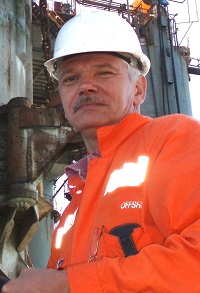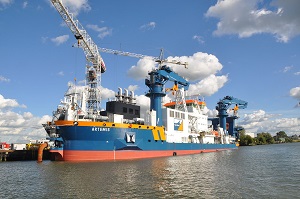Convention Will Impact Freshwater Ballasting
Some ships have been filling their ballast and trim tanks with freshwater - either drinking quality or technical - for a long time. It is often purchased by livestock carriers, OSVs that also supply drill water, and other vessel types that have small tanks and/or infrequent need to discharge them, partly or completely. Many of these ships have water makers to supplement if not fully achieve their potable water storage needs.
“Back in 2009, the UK noted to MEPC that many vessels below 3,000 gross tons could find it difficult to comply with the ballast water management convention due to lack of space or power to install and run a separate BW treatment system,” says invasive species specialist Dr Rob Hilliard, principal at Intermarine Consulting. “Since the UK considered the risk of discharging drinking quality water was negligible, it sought clarification if such discharges could be exempted. It’s also interesting that Guideline 3 of the convention, which is aimed at facilitating an equivalent ballast water management standard among SAR vessels and yachts, recommends the option of purchasing ‘dockside water’ in place of seawater”.
MEPC considered the UK’s submission (MEPC59/2/17) by seeking advice from its ballast water review group, which noted that military ships and mega-yachts had also been considering or already operating ballasting systems involving potable water. While the group felt that vessels which generate potable water for ballasting purposes should not be exempted, it recommended the issue be re-visited after a procedure for approving alternative methods of ballast water management had been finalized.
Before this occurred, a technical review of alternatives to ‘conventional’ ballast water management was released by IMO’s Globallast Partnerships Program in early 2011. This study highlighted the WHO 2008 guidelines for storing drinking water on ships, noting that adverse effects might be possible if the potable water gets contaminated by pathogens (or by sterilizing chlorination chemicals) before its eventual discharge. The pros and cons of other alternatives to conventional management, such as vessel designs that require zero or minimal ballast discharges were also reviewed.
 “Since MEPC 59, its review group has continued to recommend that vessels which use potable water for ballast should not be exempted from complying with the D-2 discharge standard,” Hilliard said. “And this will put them in an awkward position because their crew cannot always assume the water - whether made onboard or purchased ashore - will meet this when it’s eventually discharged. In fact the WHO guidelines list several reasons why drinking water in ships’ tanks can get contaminated more readily than in land based storages.”
“Since MEPC 59, its review group has continued to recommend that vessels which use potable water for ballast should not be exempted from complying with the D-2 discharge standard,” Hilliard said. “And this will put them in an awkward position because their crew cannot always assume the water - whether made onboard or purchased ashore - will meet this when it’s eventually discharged. In fact the WHO guidelines list several reasons why drinking water in ships’ tanks can get contaminated more readily than in land based storages.”
The U.S. Coast Guard examined the same question for its March 2012 ruling “Standards for Living Organisms in Ships’ Ballast Water Discharged in U.S. Waters” and in contrast to MEPC, decided to include the use of drinking water as a ballast water management option, provided it is purchased from a U.S. public water supply that meets national drinking water standards. To use this option, vessels buying the water must maintain a record of which public water supply they received it, and ensure it is placed in tanks that have been cleaned or never held ambient waters.
In November 2012 the issues surrounding the ballasting of drinking water led Netherlands to submit to MEPC the details of an alternative ballast water management system proposed by Van Oord, seeking a ‘Basic Approval’ from GESAMP under the G9 process (MEPC 65/2/2). Van Oord specializes in dredging and offshore engineering projects, and much of its fleet of propelled and non-propelled vessels have very compact designs, with small ballast capacities (<450 m3), long storage intervals and substantial equipment that occupies spaces where a conventional ballast water treatment system might otherwise fit. These vessels also work and move between port and coastal waters projects where BW needs most management.
Van Oord therefore put forward an ‘in-house’ system to ensure any ballasted drinking water, however sourced and stored by vessels within its fleet, could comply with D-2 at discharge. The system involves tank sampling, dosing and stream monitoring linked to ballast pump control, to ensure there is adequate follow up chlorination (hypochlorite) of the water that is either purchased or made onboard, plus neutralization before discharge (neutralizing sodium bisulphite is added only if residual oxidant levels exceed 0.2 ppm at the time of discharge).
GESAMP’s Ballast Water Working Group (BWWG) recommended its Basic Approval in December 2012, noting the method was acceptable only for “pre-treated (typically drinking) water”. The BWWG also noted the proposal had been unusual to evaluate, owing to the small volumes involved, the atypical ballasting patterns and the manual nature of the dosing and monitoring system.
For OSVs, barges and other vessels needing to discharge relatively small quantities of ballast after arriving in Australian ports, pre-departure purchase of drinking water from a supply barge or shipyard is presently allowed as an alternative to deep sea ballast water exchange, provided the delivery docket is kept as evidence of the purchased volume, and this water is not mixed into unwashed seawater tanks.
“A specific water quality certificate showing criteria such as suspended solids and bacterial content is not required, so the present arrangements may need to change when the convention enters into force, unless specific exemptions or alternative management arrangements are sought and granted under Regulations A-5 and B-3-7 and their associated risk assessments.” says Hilliard.
In March 2013, the drinking water issue was raised again to MEPC, this time in a joint submission by Germany, Netherlands, Norway, UK and the International Chamber of Shipping (MEPC 65/2/14). Their submission re-iterated why many smaller ships may well find it difficult to adhere to the convention, and proposed that drinking water purchased for ballast from a public water supply in the European Union will allow them to comply with the convention’s objectives.
Noting that most EU public supplies follow the EU’s Drinking Water Directive (98/83/EC), which does not conflict with the D-2 standard, the submission also highlighted the similar option adopted by USCG’s 2012 ruling, as well as emphasizing that normal trading ships would not use it because of its relatively high cost and restricted delivery during routine cargo unloading. With respect to the potential presence of ‘Active Substances’, the submitters recommended that an ‘umbrella’ G9 approval, based on pertinent advice from the BWWG, would facilitate a decision on the matter.

In the case of ballast management systems using onboard water makers, the group proposed these should undergo a G8+G9 Type Approval process that takes note of GESAMP’s earlier recommendations regarding the Van Oord system. The same would also apply to any system that uses a land-based source but subsequently treated onboard to ensure D-2, because of the need for the vessel to manage the ‘active substances’.
For methods using a land-based source where no substance gets added onboard, the review group recommended a number of actions, most of which were accepted (MEPC 65/22) to form the following “action plan”:
- expand the understanding of drinking water quality and distribution standards worldwide;
- clarify the discharge risks with respect to invasive species, human health and the environment;
- undertake a risk assessment of a known water quality standard in accordance with MEPC.206(62) (i.e. the procedure for approving alternative methods of BW management); and
- establish criteria allowing ballast tanks to receive drinking water without long- or short-term storage effects.
It is widely accepted that storing freshwater in steel tanks avoids the potential for much higher corrosion rates associated with seawater storage, particularly for ballast tanks coated with old or damaged products (or none at all). However placing freshwater in tanks coated with the modern products that have been specifically tested for approved seawater storage has the potential to increase paint blistering rates due to the higher osmotic pressure, as noted by Norway in its November 2013 submission to the IMO’s sub-committee on Pollution Prevention and Response (PPR1/5/1). This raises a caution for vessels that get retrofitted with a freshwater-based ballast management system, since not all ballast tank coatings have been tested or approved by their manufacturers for such use.
“And because MEPC 66 and 67 have had to tackle the bigger issues delaying the convention’s entry into force, input to the 2013 action plan for resolving the management of purchased drinking water has clearly taken a back seat”, says Hilliard. “But the importance of maximizing global uniformity will probably see some pushes coming the offshore energy, construction and livestock sectors of the shipping industry, as they will want to avoid any notable disparities with the USCG’s 2012 ruling.”
The opinions expressed herein are the author's and not necessarily those of The Maritime Executive.
